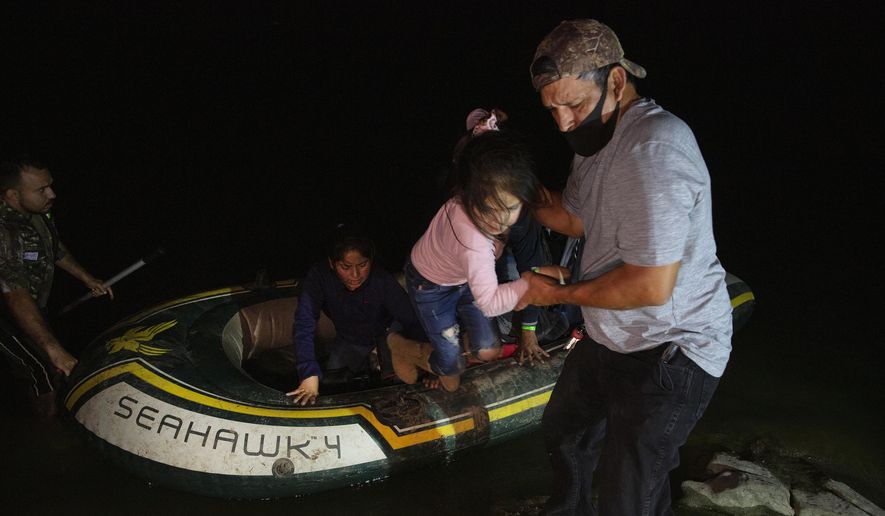A 36-year-old Brazilian man caught jumping the border over the weekend pointed to an 8-year-old girl with him and claimed she was his daughter.
Agents didn’t believe him. After questioning the two immigrants, they realized their stories didn’t match up. The man then admitted he was a friend of the child’s mother in Brazil and was using the girl to pretend to be a family, hoping to take advantage of the more lenient treatment U.S. policy affords parents who show up with children in tow.
Fake families plagued border authorities during the 2019 surge, and experts say they are pouring through again.
Yet the Homeland Security Department’s use of DNA testing to validate family relationships has plummeted more than 90% this year, according to the latest statistics.
From Oct. 1 through March 29, just 76 families had been flagged for DNA testing, and only three showed no relationships. No one was prosecuted.
In fiscal year 2020, U.S. Immigration and Customs Enforcement recorded 2,272 supposed families tested, and 120 came back as no relation. Authorities brought 100 prosecutions.
Over the final five months of fiscal year 2019, including the height of the last border surge, ICE conducted 1,086 DNA tests on purported families, and 167 indicated no family connection at all — a 15% fraud rate. Prosecutors brought 134 cases.
Todd Bensman, senior national security fellow at the Center for Immigration Studies, called the drop in testing “completely pathetic” during a migrant surge.
He said the problem appears to be that Homeland Security didn’t anticipate the family surge and didn’t have DNA testing kits on hand.
“I don’t think it’s an issue of we don’t want to deploy them. I think it’s an issue of they were taken by surprise,” he said.
Kits have been requested, he said, but ICE’s Homeland Security Investigations agents also are being used to “plug gaps” in other areas of enforcement against migrant smuggling.
Adults bring children because of a bizarre loophole in U.S. immigration policy. Under a federal court order, children who arrive with parents are supposed to be released from custody within 20 days. Because releasing the children alone would mean separating them from their parents, the entire family is usually set free.
Smugglers and would-be migrants figured that out and began to bring children, including those who didn’t belong to them.
Although some families are being turned back under a coronavirus emergency order, the majority are not.
Customs and Border Protection said it does try to sniff out cases at the border and then turn them over to ICE for investigation.
CBP told The Washington Times that its personnel observes interactions between children and adults. If something seems off, they have the leeway to prod further. That includes checking identities against U.S. databases or contacting consulates in the migrants’ home countries.
One key tell is when the same child shows up multiple times at the border, each time with a different adult. Agents call them “recycled” children.
ICE said DNA is only one of the tools it uses to try to spot impostors.
The agency said its agents also “rely on a myriad of data inputs and their experience to determine whether a group presenting as a family unit presents with indicia of fraud, based on law enforcement observations, documentary evidence, or other intelligence.”
The consequences for children when fake families are overlooked can be grim.
In Illinois, a man and a woman from Guatemala were reported after a babysitter suspected child abuse.
An investigation by local police and Homeland Security Investigations agents concluded that the man and woman crossed the border separately. Each brought a child acquired in their home country specifically to pretend to be families, authorities say.
Olga Choc Laj came to the U.S. in February 2019 with a 15-year-old girl who was forced to go to work. Her $360-a-week paycheck was confiscated to pay the smugglers who brought them to the U.S.
Santos Teodora Ac-Salazar came three months later with another girl, who was forced to keep house for the couple and feed and clean their biological baby. The girl — whose age was listed in court documents as “approximately 10 years old,” an indication of how little authorities were able to learn about her — told authorities she was threatened and beaten when she failed in her household duties.
Ac-Salazar was convicted on child abuse charges in state court, and both adults still face federal charges.
Walfrie Eliseo Camposeco-Montejo promised a woman in Guatemala that if she gave her 12-year-old son to him to make a run to the U.S. border, he would send the boy to American schools.
Once in the U.S., he reneged. He forced the boy to work 10 hours a day, six days a week, picking peppers at a Florida farm, authorities said.
Figuring out who qualifies as a family can be contentious.
During the previous surge, some Democrats on Capitol Hill, including Rep. Alexandria Ocasio-Cortez of New York, complained that the definition was too narrow when it meant separating children who showed up with an aunt or elder sibling.
Ms. Ocasio-Cortez said those separations ignored the “cultural context” of Hispanic families, where “what gets defined as family is different.”
But the law is clear, authorities say: Only a parental relationship counts for purposes of portraying as a family unit. Under current policy, any child showing up without a biological parent is deemed unaccompanied and must be quickly transferred to the federal Health and Human Services Department.
• Stephen Dinan can be reached at sdinan@washingtontimes.com.




Please read our comment policy before commenting.